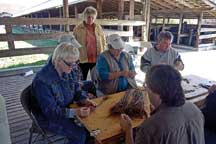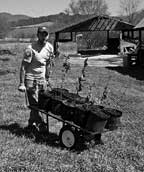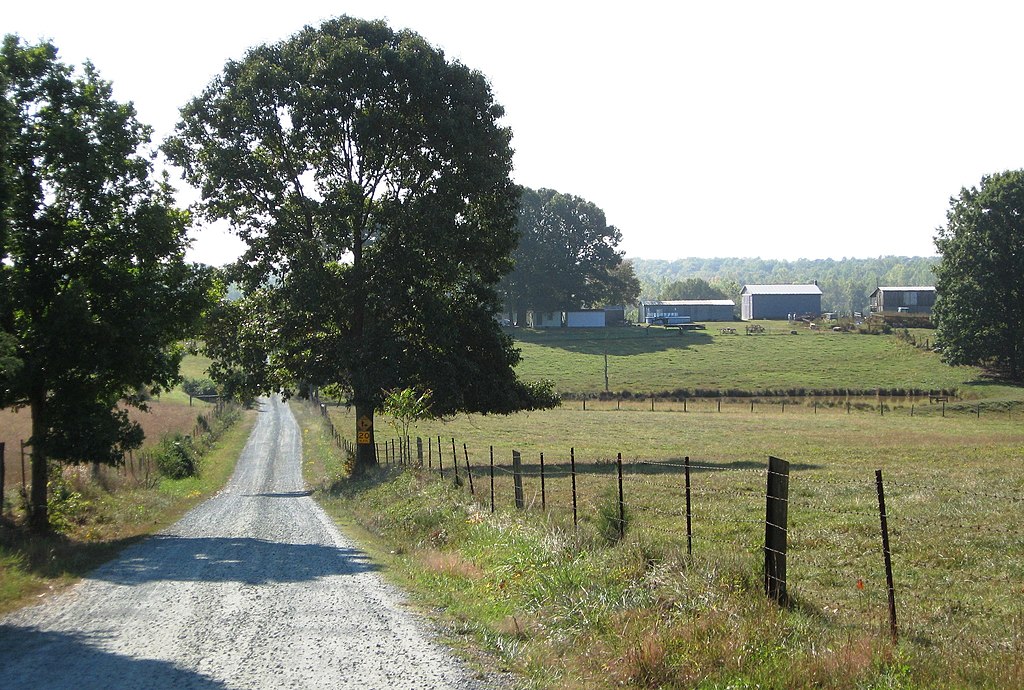Taking the Price Tag Off Our Heritage
Story by Sarah Vig

Community members carefully graft their own heirloom apple trees during a workshop at the Center for Cherokee plants located near Bryson City, N.C. More trees were also grafted to start an heirloom apple orchard at the Center and at the new Cherokee high school. Photos by Jessica Long
At the Center for Cherokee Plants, the seeds are not for sale.
“People will stop by and ask us if we sell the plants, or why we aren’t trying to sell our seeds,” said
Kevin Welch, who founded the Center, “I tell them ‘you can’t put a price on your heritage.’”
When confronted with the spinning rack filled with shiny and colorful packets of well-labeled seeds at your local Big Box store’s Garden Center, it’s difficult to imagine a different way to get your seeds. But all across Appalachia, seed saving and spring seed swaps have long been a way to get all the seeds one would need for a garden without having to spend a cent. Seed saving and swapping also helps to perpetuate locally adapted species of plants, and preserve biodiversity, whereas buying mass distributed and biologically streamlined seeds compromises these ecologically important characteristics.
Heirloom seeds are especially sought after by many gardeners for precisely these reasons. To be categorized as an heirloom, the variety must be at least 50 years old. In addition, the seeds must come from plants that were open-pollinated and must plant “true to type,” meaning the plant that grows from the seed has the same characteristics as the parent plant.
“Heritage crops are important because they represent a living link between people and history,” said Phillip Hash, a member of AmeriCorps Project Conserve who worked with the Indian Country Extension Office and Roanoke College to coordinate an heirloom apple tree grafting workshop at the Center in early March.
Unlike many other plants, apple seeds are almost never true to type. The only way to reliably preserve apple varieties is by grafting a piece of the parent tree, called a scion, to rootstock. At the March workshop, two Roanoke College professors and experienced apple-grafters, Dr. David Scaer and Dr. Jon Cawley, taught Cherokee community members how to do grafting using scions from over 30 varieties native to the region.
Because apple trees only produce for 60 years or so, apple tree grafting is an important skill to keep alive. “As your oldest humans die, your oldest trees die,” Cawley explains, so it falls to each new generation to restore the orchard stock.
“Cherokee apple varieties were actually saved and curated right after the Cherokee Removal and the Trail of Tears by two very wise gentlemen,” said Cawley. Silas McDowell in western North Carolina and Jarvis Van Buren from Georgia “rescued the original varieties so that they can be re-established on sovereign Cherokee land today,” Cawley said.
The two professors also credit western North Carolina native Tom Brown for the preservation of many of the varieties they were able to bring to the Center. Calling Brown’s collection, “encyclopedic,” the two explained that many of the varieties Brown has found and preserved have “never been seen in the outside world.”
During the course of the workshop, participants were able to graft trees to take home and help Americorps members do grafting in an effort to establish a heritage orchard at the Center for Cherokee Plants and at the new Cherokee high school. “After several generations, it is a very high privilege for me to be a part of the project to replant [the Cherokee people’s] original rare apple varieties on their sovereign estate,” Cawley said.
At the end of the workshop, Hash, Scaer, and Cawley set to work on grafting three very special apple trees. The three trees were each grafted with two different apple varieties, Nickajack and Junaluska; both have specific cultural importance to the Cherokee people.
The Nickajack apple–cited by author Gary Paul Nabhan as one of North America’s “most endangered foods” in his book Renewing America’s Food Traditions–originated on Cherokee land, and is named for Nickajack Creek on the banks of which the tree originally grew. The Junaluska apple was the personal favorite apple of Cherokee Chief Junaluska and because of this was a negotiating piece in the land deal made with the U.S. government that ended in $50 being added to the price.
The trees have different destinations, one will stay at the Center for Cherokee plants as part of their heritage orchard, one will be planted at the new Cherokee high school, and the third will be a gift from the Eastern Band of Cherokee Indians to the Western Band.
“When you eat an heirloom apple,” says Scaer, “you are tasting that place [where the variety came from]. “There’s an instant sense of meaning,” Cawley adds, echoing Scaer’s sentiment.
It is this sense of place, of meaning and cultural history that the Center for Cherokee plants strives to preserve by preserving heirloom species. Along with their efforts to establish a heritage orchard, and serve as a seed bank for Cherokee gardeners, they also are trying to retain and renew their cultural heritage through a memory bank, which documents oral histories along with seeds, and by reestablishing culturally significant native species on the site.
“The problem with traditional Cherokee art is that the resources are becoming scarce,” said Sarah McClellan-Welch, the Extension agent working on the project. In an effort to offset this problem, the Center is working on reestablishing river cane and white oaks, both of which are used for basket weaving, as well as bloodroot, which is traditionally used for dying.

Three young girls from the Cherokee community dip newly grafted heirloom apple trees in a container of warm grafting wax in order to “seal the deal,” and make sure the graft holds.
To do this, however, they are having to battle aggressive invasives such as multiflora rose on the riverbanks and Johnson grass on the flat ground. They are also conducting research on the white oaks planted on the site, as the natural conditions that made the white oak trees good material for basket-making are proving difficult to replicate. In the wild, white oaks would grow out of rhododendron thickets slow and straight, which makes the woods grain perfect for traditional arts and crafts; planted alone, however, the trees grow fast and spindly.
Once the species are established, the Center hopes to become a place where Cherokee people can harvest the crops they need to continue the traditions which depend on them, whether that is traditional agriculture, traditional foods or traditional crafts.
“There is belonging to a heritage, and then there is living a heritage. I choose to live my heritage,” said Welch.
Related Articles
Latest News

Leave a comment
Your email address will not be published. Required fields are marked *
One response to “Taking the Price Tag Off Our Heritage”
-
I just had my first Nickajack Apple! Reading this history gives me “weep-y” feelings.
Best to you all, with deep thanks, Margofrom NW Whatcom County Wa.






Leave a Comment